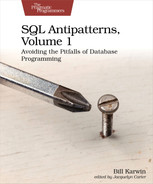Types of Antipatterns
This book has four parts for the following categories of antipatterns:
- Logical Database Design Antipatterns
-
Before you start coding, you should decide what information you need to keep in your database and the best way to organize and interconnect your data. This includes planning database tables, columns, and relationships.
- Physical Database Design Antipatterns
-
After you know what data you need to store, you implement the data management as efficiently as you can using the features of your RDBMS technology. This includes defining tables and indexes and choosing data types. You use SQL’s data definition language—statements such as CREATE TABLE.
- Query Antipatterns
-
You need to add data to your database and then retrieve data. SQL queries are made with data manipulation language—statements such as SELECT, UPDATE, and DELETE.
- Application Development Antipatterns
-
SQL is supposed to be used in the context of applications written in another language, such as C++, Java, PHP, Python, or Ruby. There are right ways and wrong ways to employ SQL in an application, and this part of the book describes some common blunders.
There are many other antipatterns related to general software development or operations, but this book focuses on the SQL language.
In addition, you’ll find mini-antipatterns throughout the book, between chapters. These cover other mistakes commonly made by developers using SQL. Mini-antipatterns are covered more briefly than the main antipatterns.
Many of the antipattern chapters have humorous or evocative titles. It’s traditional to give both positive design patterns and antipatterns names that serve as a metaphor or mnemonic.
The appendix provides practical descriptions of some relational database theory. Many of the antipatterns this book covers are the result of misunderstanding database theory.
